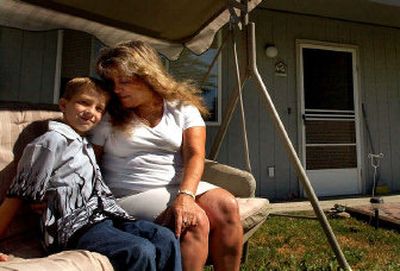A home of their own

SPIRIT LAKE, Idaho – Family photos line the hallway of Kim Carlson’s home, showcasing the lives of her two children, Nicole and Daniel. In the corner are two pictures of a brilliant pink and purple North Idaho sunset, shot by Carlson from the backyard of her home.
The photos are more than sentimental keepsakes. They’re representations of the life Carlson has built for herself and her children.
She joined the Idaho Housing and Finance Association’s family self-sufficiency program in 1999, making it her goal to own her first home.
Carlson was looking for something different when she moved from Chicago to Coeur d’Alene 15 years ago. A victim of domestic abuse, she wanted to show her young daughter a better life. But mountains of debt and the burdens of single motherhood made it difficult to get ahead, and for years she struggled to pay her bills and save money.
She began receiving rental assistance through the state association. Now, Carlson is the owner of a three-bedroom home.
The 46-year-old is a shining example of how government-supported housing assistance programs help people who need it most, said Bette Woinowsky, the family self-sufficiency program specialist in the housing association’s Coeur d’Alene branch.
“She has faced several hardships but never gave up,” Woinowsky said. “I am excited for her.”
Carlson’s daughter, now 17, suffers from bipolar disorder and has been in and out of juvenile detention centers and hospitals. Her 10-year-old son, Daniel, has been there every step of the way, seeing things most children can’t imagine, she said. Her children helped inspire her to complete the program, Carlson said.
“I wanted to prove to my kids that I’m going to get them a house,” she said.
Carlson closed the deal on the 1,120-square-foot home in April.
“It’s real exciting each time I can help a homeowner make that transition,” Woinowsky said.
A component of the federal government’s housing choice voucher program, the self-sufficiency program is designed to help people dependent on social services learn to support themselves. Career and money management counseling is available, and participants are shown how to control their debt and clean up their credit.
“They wouldn’t do it for you,” said Carlson, a cook and nutrition educator at Head Start in Rathdrum. “You would have to do it.”
Participants are required to make self-sufficiency a goal and have a goal regarding their employment opportunities.
“It gives them just a very down-to-earth program,” Woinowsky said. “It helps them understand in very simple terms about insurance, about investment – because of a lot of times, quite truthfully, those can be overwhelming.”
More than 200 Idahoans are enrolled in the program, 51 of them in North Idaho. Success stories like Carlson’s take years, Woinowsky said, and require a level of commitment that can be challenging to maintain.
“It’s a lot of hard work for a single mom,” she said.
Participants sign up for five years with the program, though extensions are granted, as they were in Carlson’s case. She had lots of problems to work through: a mountain of debt, a troubled daughter, legal battles with Daniel’s father.
“It was just like one on top of the other,” she said.
Sometimes the laborious paperwork didn’t seem worth it, Carlson said.
“Sometimes I was just like lazy,” she said. “I don’t want to work on those credit reports every stinking time you turn around.”
But she had seen her baby sitter complete the program and knew she could do it, too. She knew she owed it to her children to do it, she said.
When a sunny summer day would keep her inside working on her credit reports, “I would always tell them, ‘This is for the house,’ ” Carlson said.
Finding an affordable house is becoming more challenging for program participants, Woinowsky said.
“When I started, $85,000 was great,” Woinowsky said. “Now it’s just like, ouch, $185,000, and it’s hard to find even something for that.”
Carlson needed someone from her home loan company to approve the house, and finding something in the $140,000 range that was satisfactory sent the former Coeur d’Alene resident to Spirit Lake.
As program participants begin earning more and paying off more debt, they contribute more toward rent. The extra money they contribute gets placed in a savings account to be given to them upon successful completion of the program.
Carlson plans to use money from her savings to get a pole barn built for storage in the backyard. She plans to use her tax return money to build a fence around the house.
She talks to Daniel about the importance of working hard and saving money, but she said serving as an example for him is what really makes the difference.
When she withdrew money for a down payment on the pole barn, she gave the cash – about $2,300 – to Daniel for him to hold.
“I said, ‘That’s all the hard work I put into savings,’ ” Carlson said. “You have to learn to save or else you won’t get that pole barn.”
Besides the monthly mortgage payments deducted from her paychecks, Carlson is debt-free and independent of state services. She considered applying for a state program that helps finance child care for when school starts in the fall, but she decided she didn’t want the burden of more dependency.
“After doing it for so many years it’s like, OK, I don’t want to do any paperwork,” Carlson said. “I don’t want to go back to that.”